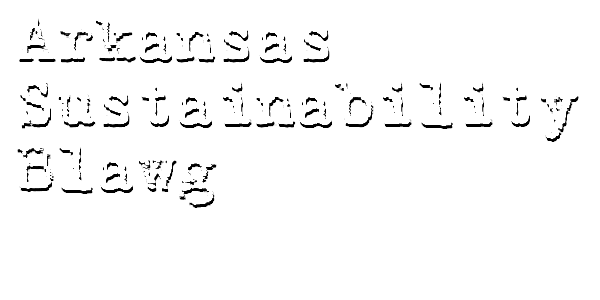So here is where we are:
Mayor Stodola recently pledged Little Rock to reducing greenhouse gas emissions by signing the “Mayor’s Climate Protection Agreement.” (See: http://www.usmayors.org/climateprotection/revised/).The City of Little Rock also received federal stimulus funds. Whatever your political sentiments, there is no question that the funding helped stimulate the local sustainasphere. The funds provided capital to:
The City of Little Rock Board of Directors adopted a resolution calling for all newly constructed city buildings to be LEED-certified.
The city is in the process of retrofitting all street lights and buildings with LED lighting. The city is also replacing outdated HVAC systems on city buildings.
The Mayor formed a Sustainability Commission, which is comprised of 7 to 15 Little Rock residents. The Sustainability Commission is charged with providing educating, leadership, and vision for the Little Rock sustainasphere. Sustainability Commission action areas include organizing and promoting the Little Rock Sustainability Summit and sub-committees on Green City Operations, Sustainable Economic Development & Green Jobs, and Built Environment and Land Use.
The Mayor also recently formed a city “Green Team.” The Green Team is a group of city employees, one from each city department, charged with finding opportunities for sustainable initiatives in each department. The Green Team will also help coordinate sustainable efforts among and between city departments.
Develop a new, LEED-certified police substation on 12th Street in Little Rock;
Replace or add to midtown 2.5 miles of sidewalks to Little Rock’s Midtown community, making for a more walk able neighborhood;
Create Little Rock’s Green Building Financial Incentive Program. Under this Program, contractors and/or owners of qualifying new residential and commercial
construction are eligible to receive an incentive of up to $1500 to cover cost of LEED, Energy Star, “Green Built,” or similar nationally recognized green building certification;
Complete several cycling and pedestrian projects in Pulaski County, including The Arkansas River Trail and completion of the Clinton Bridge, and construction of a pedestrian bridge over the Little Maumelle River to Two Rivers Park, which connects an extensive network of existing walking and cycling trails;
Install specialized equipment at the Little Rock landfill to convert methane gas into other forms of usable energy, as opposed to releasing the gas into the atmosphere; and,
Purchase and install equipment at the Little Rock Zoo that transforms elephant waste (i.e., poop) into compost, which is then provided by the Little Rock landfill to
consumers at extremely low cost.
The Mayor also emphasized the mixing preservation and conservation by giving old buildings and neighborhoods new life. For example, one building at 315 Main Street in downtown Little Rock had been vacant for 30 years, much of the time with 8 feet of standing water in the basement. Engineers recommended the building be torn down, despite its place as part of the historic core of downtown. Through partnership with a local developer, Reed Realty Group, 315 Main will be renovated into a LEED certified combination of residential apartment and loft space and world-class jazz café and night club.
Likewise, in partnership with Greenmore Homes, the City has used Neighborhood Stabilization Program II funds to take a derelict inner-neighborhood homes and properties and turn them into Energy Star rated affordable homes. (This is sometimes referred to as the “Eyesores to Energy Stars” Project; see my previous post.)
That is a significant amount of activity for a city like Little Rock over the course of a year. The good thing, as I will cover in my next post, is that it appears that we can expect more of the same. Stay tuned.

No comments:
Post a Comment
I welcome your comments. By commenting on this blog, you accept the blog's terms of use. You must use your first and last name when posting, and you must stay on topic.